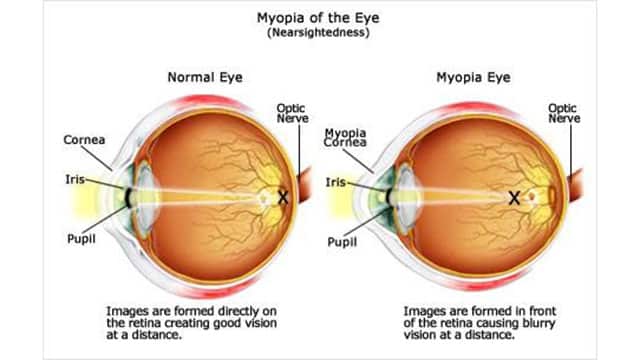Myopia

What is myopia?
Myopia is also known as nearsightedness, or “sight at near.” Near vision is unaffected, but it is difficult to see far away objects like a TV screen or the whiteboard at school.
Myopia can occur in three ways:
-
- The eyeball grows too long from front to back.
- The cornea (front surface of the eye) is too steeply curved.
- A combination of the above.
As a result, the light entering the eye bends too much causing the light to focus at a point before it reaches the retina. This causes distant objects to appear blurred.
What are symptoms of myopia?
Symptoms of myopia are fairly easy to recognize.
Besides blurry distance vision, signs and symptoms of myopia can include squinting, headaches, eye fatigue, eye rubbing, and a general unawareness of distance objects.
The most common complaint from school-aged children is that they have difficulty seeing the board.
Who does myopia affect?
In 2010, the World Health Organization estimated that 27% of the world population has myopia.
Typically, myopia will begin in childhood.
As the eye continues to grow, myopia will often increase in severity until about age 20 when the growth process has been completed. Although myopia typically stabilizes in early adulthood, it can continue to progress with age.
Myopia may be inherited, or the tendency to develop myopia, if one or both parents are nearsighted.
However, visual stress or health conditions can also cause myopia to develop in adults.
How a person uses his or her eyes may affect the development of myopia. Individuals may be more likely to develop myopia if a considerable amount of time is spent reading, working at a computer, or other intense visual work.
People with diabetes can have symptoms of myopia as a sign of variations in blood sugar levels.
Myopia symptoms can also be an early sign of a developing cataract.
How is myopia diagnosed?
An optometrist or ophthalmologist can diagnose myopia through a comprehensive eye exam.
Several tests and procedures may be used to examine your eyes. Depending on the doctor and the number or tests required, a comprehensive eye exam can take an hour or more. All tests are important to fully evaluate vision and eye health.
How is myopia treated?
Myopia can be corrected with eyeglasses, contact lenses, or refractive surgery. Glasses or contacts may need to be worn at all times or just for certain activities like driving or seeing the board. It all depends on the degree of nearsightedness.
During a comprehensive eye exam the doctor will use a device called a phoropter to determine what lenses will best correct a patient’s vision. In young children, the doctor may use retinoscopy to determine the best correction needed.
Eyeglasses or contacts can be used to refocus light onto the retina for clear vision. The results from the phoropter are written as a prescription. On a nearsighted prescription, the first number (“sphere”) will be preceded by a minus (-) for the type of lens. The stronger the lens (i.e. higher minus), the more nearsighted you are. All refractive errors like nearsightedness are measured in units called diopters that indicate the strength of the lens.
Once myopia has stabilized around age 20, refractive surgery can be an option for correction.
The two most common refractive surgeries are:
- laser-assisted in situ keratomileusis (LASIK)
- photorefractive keratectomy (PRK).
Both surgeries involve reshaping the cornea to better focus light onto the retina.
Can myopia lead to blindness?
Myopia itself usually does not lead to vision loss. However, individuals with high myopia are at a greater risk of developing other vision-threatening conditions like retinal detachments, cataracts, and glaucoma.
It is important for people with high myopia to have regular eye examinations to monitor the health of their eyes and check for signs of complications.
What is high myopia?
High myopia is a severe level of nearsightedness caused by excessive elongation of the eye.
An eye is considered to have high myopia if it requires a lens correction of -6.0 diopters or more. Visual acuity in high myopia is 20/400 or worse.
People who develop high myopia typically become nearsighted in early childhood and their myopia gets progressively worse year after year until age 18-20.
As the eye continues to grow abnormally long in high myopia, the retina can become thin and lead to retinal tears and retinal detachment.
Individuals with high myopia are at a greater risk of developing retinal detachments, cataract, and glaucoma.
